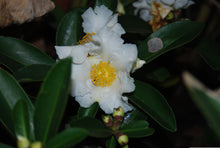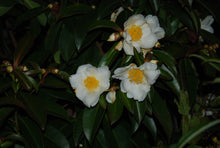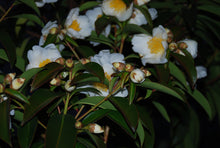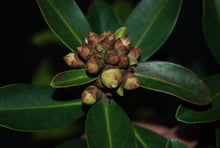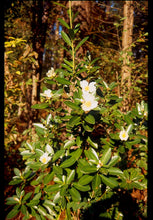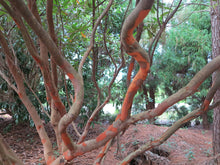Polyspora axillaris 'Shibamichi Select'
Regular price
$45.00
Sale
Shibamichi Fried Egg Tree. This is quite an unsophisticated common name for such an elegant selection. This species has long been recognized as being in the genus Gordonia by many, but the correct genus is now Polyspora. None-the-less, it is in the Camellia family, Theaceae with our native Gordonia lasianthus or Loblolly Bay. Its native habitat extends from southeastern China, northern Vietnam over into Taiwan. It has 3-4 inch single Camellia-like flowers with white petals and yellow stamens. The common name of "Fried Egg Tree", commonly used in Australia and New Zealand, comes from its proclivity to shed its flowers to the ground completely intact, with its face up, giving the appearance of a fried egg staring one in the face. I saw this selection in the garden of Mr. Akari Shibamichi, in Kawaguchi City just north of downtown Tokyo, whom we consider a Japanese national treasure because of his knowledge of plants, both Japanese and Chinese. I consider this to be one of the best selections of this species because it begins to flower in September; whereas, other selections of this species' flowers don't start to open until about mid to late November. Since it flowers over a period of about 2 months, later blooming selections often get cut short by the cold because they extend well into December. This probably should be considered a zone 8 and 9 plant, and even in the upper extremities of its range, it is recommended to give it some protection from northwest winds. We have had this cultivar survive here at the nursery down into single digits for short periods of time with no apparent damage, even when in a container. (With the polar vortex at Christmas 2022, we had 12°F and 40 mph winds. This selection showed some of the least damage of any plant on the nursery, with no burnt leaves at all.) In my garden, it has performed well in filtered sun, under tall pines and has survived single digits for brief periods. It has the amazing ability to set from 10 to 20 flower buds at the terminus of each stem, to the point that the branch tips will sag with their weight. I have even counted well over 30 flower buds quite often at the tip of a single branch. As one bud opens and falls, another one follows, and this process continues for at least 2 months. I would suppose that the mature size is from 20-30', which is much smaller than our native Gordonia lasianthus or Loblolly Bay. The last picture is compliments of Bobby Green of Daphne, AL, showing the branch structure and exfoliating bark of an older specimen of this species. They begin flowering when quite young, and the plants we offer should flower at the end of the following growing season.
Zones 7b-10







